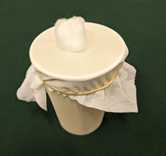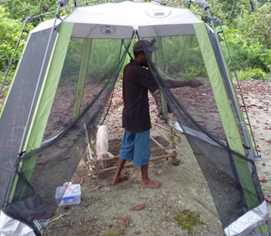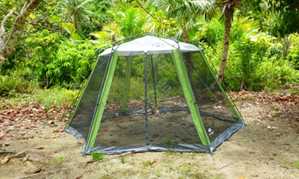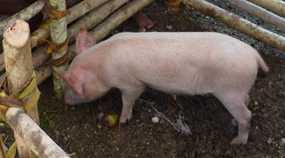Standard Operating Procedure for animal baited tent traps to sample host-seeking mosquitoes
Tanya L L Russell, Kyran Staunton, Thomas R Burkot
Disclaimer
This Standard Operating Procedure may be used for training and reference purposes. Users are responsible for ensuring any edits to this document are produced and approved in accordance with all relevant legal and ethical requirements governing the surveillance operation.
Abstract
This Standard Operating Procedure (SOP) outlines the materials and processes required to deploy animal baited traps to collect host-seeking adult mosquitoes.
Description: The principal behind animal baited tent traps is to utilise an animal host as a bait to attract mosquitoes, which are then trapped by the tent structure. This type of trap attracts zoophagic mosquitoes.
Target species and physiological states: Captures host-seeking females of many species.
Entomological surveillance indicators: Adult vector occurrence, density and biting time.
Advantage: This method uses cheap materials and can be easily constructed.
Disadvantage: This method is labour intensive.
Sampling period: The animal baited tent traps are often deployed overnight for 12 h periods.
Data: Total number of host-seeking females per sampling effort (by species). When necessary, field data is merged with the results of subsequent laboratory analyses.
Before start
Animal ethics
Where animal ethics approval is required and granted, animals will be recruited following standard informed consent procedures. The potential risks and benefits of using animals for mosquito sampling will be discussed verbally in the local language. It will be explained that the animal should not be unduly stressed, managed by its owner and have access to food and water.
Attachments
Steps
Sampling procedure
Before setting up the animal-baited trap, the owner of each animal must be asked for permission to participate in the experiment. It is generally good to hire the animal’s owner to collect mosquitoes need the animal to avoid unnecessarily stressing the animal.
Secure the animal inside the tent with the stake or pen, at the start of the sampling period.
a.This step must be completed by the owner of the animal.
b.When using a large animal like a cow, tie the rope securely to the headstall of the animal, guide it into the tent and secure the rope to the wooden peg.
c.Make sure that the animal cannot pull itself loose and that the rope does not cause it stress or harm.
d. Ensure the outer structure has an opening for mosquitoes to enter (either tent doors apart or outer net raised off the ground).

Ensure collectors have equipment required for collecting mosquitoes.
At the start of the night, set up sufficient paper cups for the work. Generally, each collector will have 12 paper cups per night in total if collections occur hourly from 18.00 to 06.00. Ensure that the cups are used in the correct order for time.


To collect mosquitoes visually search inside the outer structure and catch any trapped mosquitoes with an oral aspirator.
Resting mosquitoes are generally passive and can be collected with careful visual inspections and an oral aspirator. Place mosquitoes directly into the labelled collection cups.
Start searches at a designated point in the tent and carefully walk around the entire structure back to the starting point, this should take about 10 – 20 minutes.
After entering the structure, the openings can be closed to prevent mosquitoes escaping (i.e. doors closed or edges lowered to the ground).

Temporarily store the mosquitoes in labelled collection cups until processing and long-term storage.
For details on processing and storage see Tanya Russell, Kyran Staunton, Amanda Murphy, Thomas Burkot 2022. Standard operating procedures for mosquito vector surveillance, processing and storage. protocols.io https://dx.doi.org/10.17504/protocols.io.eq2lyn13qvx9/v3
Additional notes
Mosquito collections for anopheline will be recorded for each hour between sunset and dawn but the hours of collection may be changed based on knowledge of the biting behaviours.Generally, it is good that collections start before the time of earliest biting and end after host seeking has stopped.Sometimes, partial night collections may be sufficient to monitor mosquito densities, particularly if most host biting occurs during only part of the night for anophelines.
Individuals collecting mosquitoes from the outer structure need to avoid acting as a lure that attracts mosquitoes to the barrier screen. This risk can be minimized by the collectors wearing repellent, and the collectors moving at least 10 m away from the human-baited tent in between collection periods.
Do not collect more than five mosquitoes in one sucking tube before transferring them to the paper cup.
The catches for each hourly interval should be stored in separate collection cups labeled with date, location and hour of collection.
Head torches are very useful as they provide a hands-free solution. People have used red lens (~680 nm) which is considered invisible to mosquitoes and therefore does not impact behavior.




